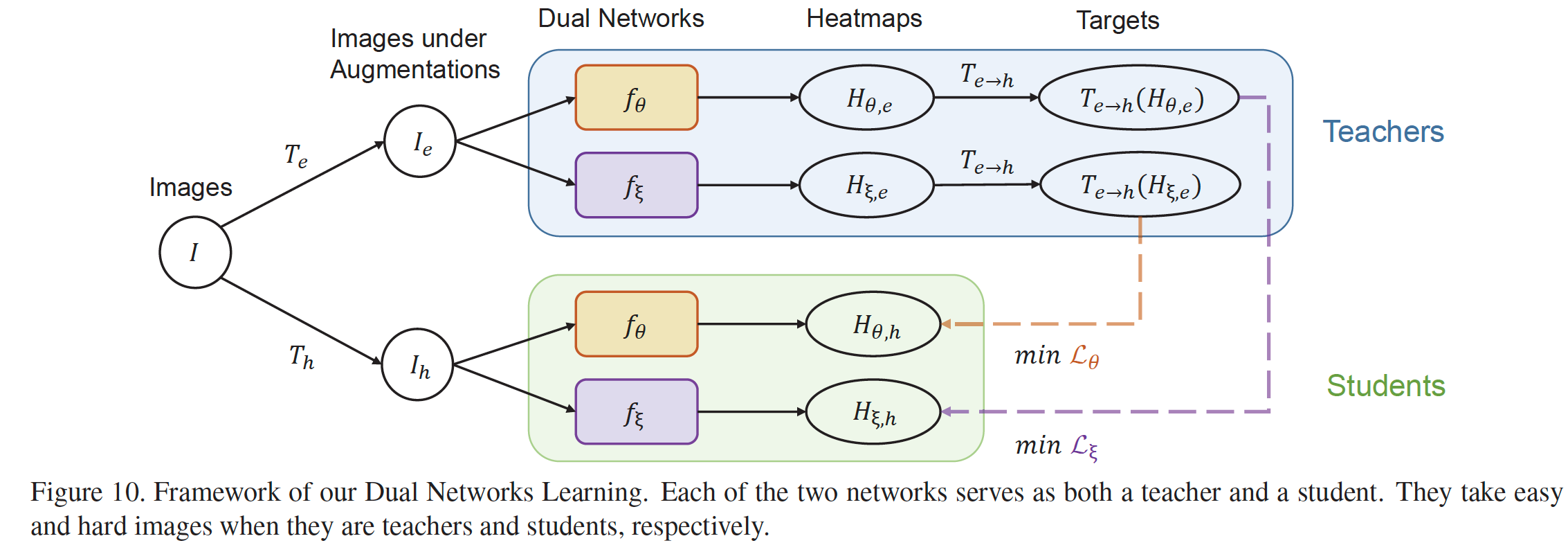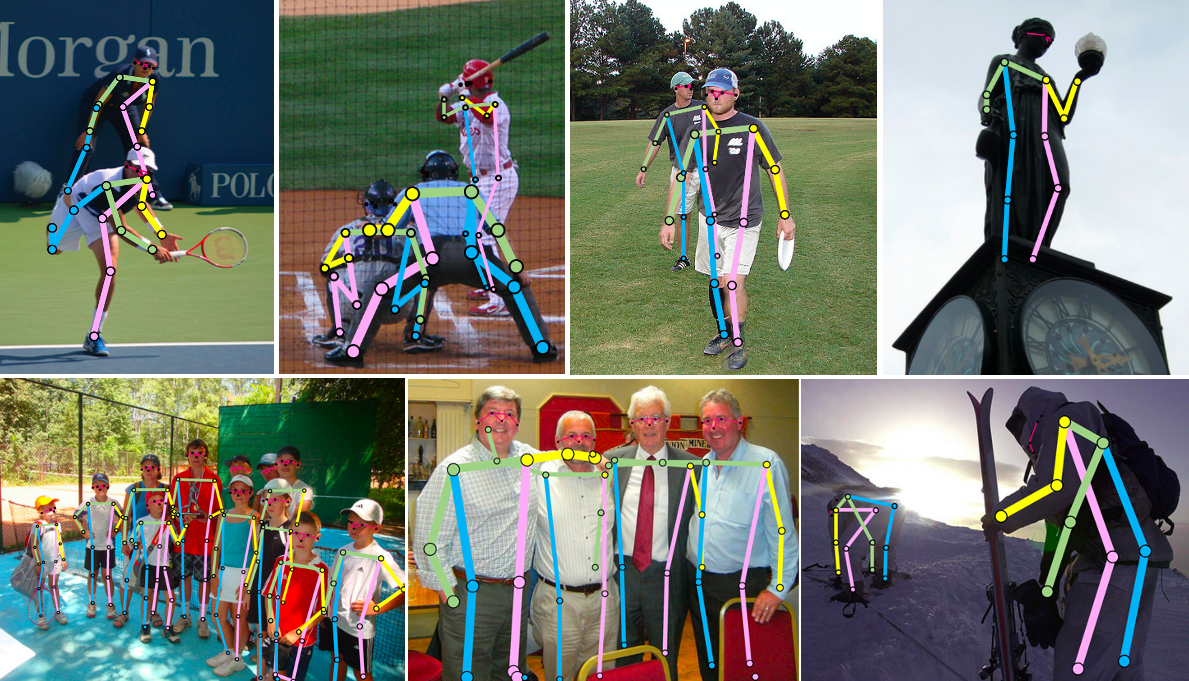An Empirical Study of the Collapsing Problem in Semi-Supervised 2D Human Pose Estimation (ICCV 2021)
This is an official pytorch implementation of An Empirical Study of the Collapsing Problem in Semi-Supervised 2D Human Pose Estimation. [ICCV 2021]
PDF | ICCV Video | Slide | Poster
Most semi-supervised learning models are consistency-based, which leverage unlabeled images by maximizing the similarity between different augmentations of an image. But when we apply them to human pose estimation that has extremely imbalanced class distribution, they often collapse and predict every pixel in unlabeled images as background. We find this is because the decision boundary passes the high-density areas of the minor class so more and more pixels are gradually mis-classified as background.
In this work, we present a surprisingly simple approach to drive the model. For each image, it composes a pair of easy-hard augmentations and uses the more accurate predictions on the easy image to teach the network to learn pose information of the hard one. The accuracy superiority of teaching signals allows the network to be “monotonically” improved which effectively avoids collapsing. We apply our method to the state-of-the-art pose estimators and it further improves their performance on three public datasets.
Results on COCO Val2017
| Method | Augmentation | 1K Labels | 5K Labels | 10K Labels |
|---|---|---|---|---|
| Supervised | Affine | 31.5 | 46.4 | 51.1 |
| PoseCons (Single) | Affine | 38.5 | 50.5 | 55.4 |
| PoseCons (Single) | Affine + Joint Cutout | 42.1 | 52.3 | 57.3 |
| PoseDual (Dual) | Affine | 41.5 | 54.8 | 58.7 |
| PoseDual (Dual) | Affine + RandAug | 43.7 | 55.4 | 59.3 |
| PoseDual (Dual) | Affine + Joint Cutout | 44.6 | 55.6 | 59.6 |
We use COCO Subset (1K, 5K and 10K) and TRAIN as labeled and unlabeled datasets, respectively
- The Ground Truth person boxes is used
- No flipping test is used.
Results on COCO Val2017
| Method | Network | AP | AP.5 | AR |
|---|---|---|---|---|
| Supervised | ResNet50 | 70.9 | 91.4 | 74.2 |
| PoseDual | ResNet50 | 73.9 (↑3.0) | 92.5 | 77.0 |
| Supervised | HRNetW48 | 77.2 | 93.5 | 79.9 |
| PoseDual | HRNetW48 | 79.2 (↑2.0) | 94.6 | 81.7 |
We use COCO TRAIN and WILD as labeled and unlabeled datasets, respectively
Download Links Google Drive
The code is developed using python 3.7 on Ubuntu 16.04. NVIDIA GPUs are needed.
-
Install pytorch >= v1.2.0 following official instruction.
-
Clone this repo, and we'll call the directory that you cloned as ${POSE_ROOT}.
-
Install dependencies:
pip install -r requirements.txt -
Make libs:
cd ${POSE_ROOT}/lib make -
Init output(training model output directory)::
mkdir output mkdir log -
Download pytorch imagenet pretrained models from Google Drive. The PoseDual (ResNet18) should load resnet18_5c_gluon_posedual as pretrained for training,
-
Download our pretrained models from Google Drive
${POSE_ROOT} `-- models `-- pytorch |-- imagenet | |-- resnet18_5c_f3_posedual.pth | |-- resnet18-5c106cde.pth | |-- resnet50-19c8e357.pth | |-- resnet101-5d3b4d8f.pth | |-- resnet152-b121ed2d.pth | |-- ...... |-- pose_dual |-- COCO_subset | |-- COCO1K_PoseDual.pth.tar | |-- COCO5K_PoseDual.pth.tar | |-- COCO10K_PoseDual.pth.tar | |-- ...... |-- COCO_COCOwild |-- ......
For COCO and MPII dataset, Please refer to Simple Baseline to prepare them.
Download Person Detection Boxes and Images for COCO WILD (unlabeled) set.
The structure looks like this:
${POSE_ROOT}
|-- data
`-- |-- coco
`-- |-- annotations
| |-- person_keypoints_train2017.json
| |-- person_keypoints_val2017.json
| `__ image_info_unlabeled2017.json
|-- person_detection_results
| |-- COCO_val2017_detections_AP_H_56_person.json
| |-- COCO_test-dev2017_detections_AP_H_609_person.json
| `-- COCO_unlabeled2017_detections_person_faster_rcnn.json
`-- images
|-- train2017
| |-- 000000000009.jpg
| |-- 000000000025.jpg
| |-- ...
`-- val2017
|-- 000000000139.jpg
|-- 000000000285.jpg
|-- ...
For AIC data, please download from AI Challenger 2017, 2017 Train/Val is needed for keypoints training and validation. Please download the annotation files from AIC Annotations. The structure looks like this:
${POSE_ROOT}
|-- data
`-- |-- ai_challenger
`-- |-- train
| |-- images
| `-- keypoint_train_annotation.json
`-- validation
|-- images
| |-- 0a00c0b5493774b3de2cf439c84702dd839af9a2.jpg
| |-- 0a0c466577b9d87e0a0ed84fc8f95ccc1197f4b0.jpg
| `-- ...
|-- gt_valid.mat
`-- keypoint_validation_annotation.json
python pose_estimation/train.py \
--cfg experiments/mix_coco_coco/res18/256x192_COCO1K_PoseDual.yaml
python pose_estimation/train.py \
--cfg experiments/mix_coco_coco/res18/256x192_COCO1K_PoseDual_JointCutout.yaml
python -m torch.distributed.launch --nproc_per_node=4 pose_estimation/train.py \
--distributed --cfg experiments/mix_coco_coco/res18/256x192_COCO1K_PoseDual.yaml
python pose_estimation/train.py \
--cfg experiments/mix_coco_coco/res18/256x192_COCO1K_PoseCons.yaml
python pose_estimation/train.py \
--cfg experiments/mix_coco_coco/res50/256x192_COCO_COCOunlabel_PoseDual_JointCut.yaml
python pose_estimation/valid.py \
--cfg experiments/mix_coco_coco/res18/256x192_COCO1K_PoseDual.yaml
If you use our code or models in your research, please cite with:
@InProceedings{Xie_2021_ICCV,
author = {Xie, Rongchang and Wang, Chunyu and Zeng, Wenjun and Wang, Yizhou},
title = {An Empirical Study of the Collapsing Problem in Semi-Supervised 2D Human Pose Estimation},
booktitle = {Proceedings of the IEEE/CVF International Conference on Computer Vision (ICCV)},
month = {October},
year = {2021},
pages = {11240-11249}
}
The code is mainly based on Simple Baseline and HRNet. Some code comes from DarkPose. Thanks for their works.

